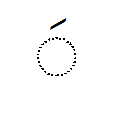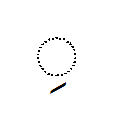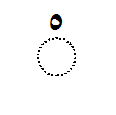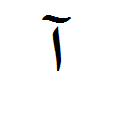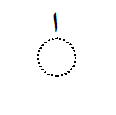Tashkil
Tashkil ( Arabic تشكيل, DMG Taškīl ), also as Harakat ( Arabic حركات, DMG Ḥarakāt ), denotes the vocalization of the Arabic consonant writing by means of a series of orthographic auxiliary characters.
Since the Arabic alphabet only contains characters for consonants and long vowels ( ā , ū , ī ), a system was created for the identification of short vowels ( a , u , i ), nominal endings ( nunation ) and some special phonetic features (such as lack of vowels or consonant doubling) Small auxiliary characters developed, which are additionally placed above or below the consonant lettering. These include the following characters:

- Fatha , a small slash (3) above, stands for a short a .
- Kasra , a small slash (3) below, stands for a short i .
- Damma , a kind of small waw (5) above, stands for a short u .
- two Ḍamma (as a ligature: 6), Kasra or Fatḥa ( Ḍammatan , Kasratan or Fatḥatan ) denote the noun endings -un , -in and -an .
- Sukun (also Jazma in the wording ), a small circle (2a, also 2b) above, means that the consonant is not followed by a vowel.
- Schadda (also called Tashdid ), a kind of small sin (1) above, marks a doubling ( gemination ) of the consonant.
Fatḥa and Ḍamma are placed above, Kasra directly below the Shadda.
Fatḥa before (in Arabic writing and reading direction) a Waw with Sukun denotes the Arabic diphthong au ; Fatḥa before a Ya with Sukun denotes the Arabic diphthong ai .
- Hamza (7) stands for the glottic opening or cracking sound , i.e. a vocal paragraph, and (according to quite complicated rules) almost always has a carrier letter ( Alif , Waw or Ya)
- Wasla (9) stands for the so-called "connection hamza" at the beginning of the word, which (to avoid double consonance) is not spoken as a glottal beat. It is always above an Alif.
- Madda (8) stands for the sound sequence (separation) Hamza + long ā and is used to avoid two successive Alifs. It is also always above an Alif.
- Alif chanjariya ( ʾAlif ḫanǧarīya ), the "dagger-alif" - scientifically also called perpendicular alif - (4), placed above, stands for a long ā (which is not marked by a normal alif in consonant letters).
However, these additional characters are used almost exclusively in Koran texts , poems and books for language learners. They are usually not found in newspapers and other books (unless as a reading aid for difficult foreign words). In order to be able to read a normal, ie unvocalized text, one must already know the pronunciation of every word (by heart) or at least master the grammatical structures, the root system and the model structures of the Arabic language .
See also
Web links
- Arabic script vocalization tool (Arabic / English)

